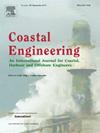The relative impact of sea level rise and dredging strategies on the morphodynamic evolution of the Western Scheldt estuary (The Netherlands)
IF 4.5
2区 工程技术
Q1 ENGINEERING, CIVIL
引用次数: 0
Abstract
Worldwide, estuaries face challenges related to climate change and human interventions. The objective of this study is to gain insight into the relative impact of (extreme) sea level rise (SLR), dredging and disposal (DAD) activities and coastal nourishments on the century timescale hydro- and morphodynamic behaviour of the Western Scheldt estuary (i.e. the Dutch part of the Scheldt river). For this, we apply a two-dimensional process-based numerical morphodynamic model including wave action (Delft3D 4), that allows for detailed analyses of the changing hydro- and morphodynamic conditions under various scenarios.
Scenario simulations for the period 2020–2100 are carried out based on downscaled SLR and tidal projections from a global tide model. Our model results suggest that SLR causes more resonant behaviour of the tidal wave and leads to less flood or increased ebb dominance throughout the estuary. Morphodynamic development lags behind SLR, which decreases intertidal area, changes the tidal asymmetry and enhances export or decreases import of sediment in the Western Scheldt. Excluding morphodynamic change in the model drowns the intertidal area even faster. Regarding possible sediment management strategies, the model indicates that the SLR induced enhanced sediment export trend can be locally counteracted by disposing a larger portion of dredged material in the more upstream parts of the estuary and/or by performing nourishments in the mouth area.
Our study shows the potential of using process-based models for SLR impact studies in estuaries albeit that more robust conclusions can be drawn when combined with other modelling approaches. Future work may improve hindcast and forecast efforts by using a three-dimensional modelling approach, adding mud dynamics and applying a more advanced wind, wave and DAD schematisation.
海平面上升与疏浚策略对荷兰西舍尔德河口形态动力学演变的相对影响
在世界范围内,河口面临着与气候变化和人类干预有关的挑战。本研究的目的是深入了解(极端)海平面上升(SLR)、疏浚和处置(DAD)活动和沿海营养对西斯海尔德河河口(即斯海尔德河的荷兰部分)世纪时间尺度水文和形态动力学行为的相对影响。为此,我们应用了一个二维过程的数值形态动力学模型,包括波浪作用(Delft3D 4),可以详细分析各种情况下变化的水力和形态动力学条件。基于缩小的SLR和全球潮汐模式的潮汐预估,对2020-2100年的情景进行了模拟。我们的模型结果表明,SLR引起更多的潮汐波共振行为,导致整个河口洪水减少或退潮优势增加。地貌动力发育滞后于SLR,减少了潮间带面积,改变了潮汐的不对称性,增加了泥沙的输出或减少了泥沙的输入。在模型中排除形态动力学变化,潮间带被淹没的速度更快。对于可能的泥沙管理策略,该模型表明,SLR引起的泥沙输出增强趋势可以通过在河口更上游的部分弃置更大比例的疏浚材料和/或在河口区域进行营养来局部抵消。我们的研究显示了在河口使用基于过程的模型进行SLR影响研究的潜力,尽管当与其他建模方法相结合时可以得出更有力的结论。未来的工作可能会通过使用三维建模方法、增加泥浆动力学和应用更先进的风、波和DAD模式来改进后推和预报工作。
本文章由计算机程序翻译,如有差异,请以英文原文为准。
求助全文
约1分钟内获得全文
求助全文
来源期刊

Coastal Engineering
工程技术-工程:大洋
CiteScore
9.20
自引率
13.60%
发文量
0
审稿时长
3.5 months
期刊介绍:
Coastal Engineering is an international medium for coastal engineers and scientists. Combining practical applications with modern technological and scientific approaches, such as mathematical and numerical modelling, laboratory and field observations and experiments, it publishes fundamental studies as well as case studies on the following aspects of coastal, harbour and offshore engineering: waves, currents and sediment transport; coastal, estuarine and offshore morphology; technical and functional design of coastal and harbour structures; morphological and environmental impact of coastal, harbour and offshore structures.
 求助内容:
求助内容: 应助结果提醒方式:
应助结果提醒方式:


